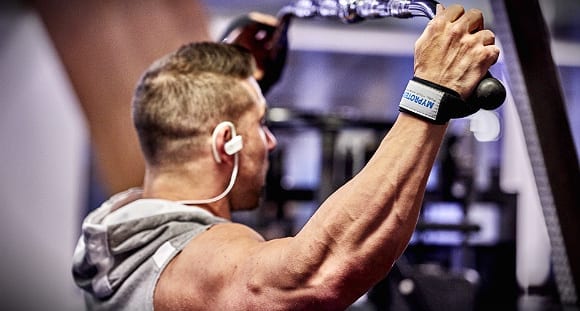
Written by Jack Boardman
Build Your Traps
If you’re not already dedicating a training day to your traps, that could be what’s missing when it comes to your symmetrical upper physique.
Located on the top half of your back, the trapezius muscles, when pumped up, make a big impression, even when wearing a shirt. Whereas the chest and other larger muscles groups are favourites when it comes to building muscle mass and a bulking look, built-up traps can make all the difference to symmetry and well-rounded shoulders. And yet, many people neglect the traps, despite the obvious gains to be made and the relatively simple exercises involved.

What are your traps?
Traps is a shortened term for the trapezius muscle. To put it simple, it has it's name because it’s shaped like a trapezium by the neck and upper back.
They are split into three sections: the upper traps, the middle traps, and the lower traps.
The upper traps:
Worked by elevating the shoulders and not the neck: e.g. performing dumbbell shrugs.
The middle fibres:
Developed by pulling the shoulder blades - (Scapula retraction.)
The lower traps:
Developed by drawing the shoulder blades downwards, as you would when performing a lat pull down.
– (Scapula depression and Scapula retraction.)
Training Your Traps
You could consider traps as part of your back and shoulders workouts, with both pressing and pulling exercises working them. Chances are, you didn’t realise to what extent you were already exercising your traps, perhaps logging them in as a generalised ‘back workout’ or thinking you were just building your shoulders or triceps with overhead presses.
Your traps will also assist you in other areas, by building strength in them you will support your overall back muscles. A good reason to dedicate a whole session to it. Typically, your upper traps are developed by elevating your shoulders with shrugs and upright rows. The middle part can be worked by pulling together your shoulder blades – think reverse fly and cable work. The lower part of your traps are developed by drawing your shoulder blades downward. To do this you should avoid working your arms as best you can by keeping them straight and stiff. Again, cable work is your friend to achieve this.
Your upper and lower trapezius fibres are also used during overhead press exercises, which in turn assist the middle fibres.

Gaining Strength
When it comes to building strength, for beginners, four sets of eight-12 reps is a good place to begin as you’ll need to ease into muscular hypertrophy as you would with any muscle. If you’re not used to lifting an excessive weight, you could suffer an injury with a wayward shoulder shrug while holding heavy weight, so building a strong foundation with a moderate weight and good technique is essential.
For more advanced lifters, volume is achieved by lifting a higher percentage of your one rep max and lowering the number of reps. We suggest three-five sets of three-five reps, lowering the number of reps when you want to increase the amount you’re lifting.
Many people opt to work their traps at the end of a shoulder workout. On the one hand, as with any exercise, if you commit to it at the beginning of a workout session you’ll be at your best. So if you’re working on strength and increasing the amount you lift, then it’s a good idea to make it your first exercise. However, to induce muscle fatigue as a means for pumped-up traps, it is highly effective to work on some muscle-isolating exercises to finish your session.

Best Trap Exercises
Barbell Upright Row
Technique- Grab a barbell and load with the necessary weight to complete your repetitions. This may not require any further weight to be added to the barbell.
- Grip the bar at shoulder width apart, while the bar itself should be resting on your thighs.
- Use your shoulders to lift the barbell as your exhale.
- Continue to lift the bar just before it reaches your chin.
- Lower the barbell back down to the starting position.
Rest: 60 seconds | Reps: 8 Sets: 4
Exercise VariationYou can use an EZ bar to perform this exercise, or you can use dumbbells too.
Cable Shrugs
Technique- Grab a straight bar attachment and put it in place so that it is on the lowest possible section.
- Stand upright, while standing close to the bar.
- While your arms are extended, with your palms facing the ground you have your starting position.
- Lift the bar upwards with your shoulder as you would with the dumbbell shrug, and slowly go back to your starting position after squeezing the contraction.
Rest: 60 seconds | Reps: 8 Sets: 4
Variation:
You can do this single arm with a cable attachment, or you can even do it with resistance bands.
Dumbbell Shrug
Technique- Grab an appropriate sized pair of dumbbells for this exercise.
- Stand in an upright position with the dumbbells by your side. This will be your starting position.
- Lift upwards by pushing your shoulders towards your ears, and squeeze for a couple of seconds.
- Slowly release, as you go back to your starting position, and this is one repetition.
Rest: 60 seconds | Reps: 8 Sets: 4
Variation:
Perform the exercise with one dumbbell at a time so you can really concentrate on the form of each repetition.
Kettlebell Sumo High Pull
Technique- Grab a kettlebell, and place it on the ground between your feet.
- Stand upright with your feet at just over shoulder width apart.
- Essentially perform a squat. Make sure your back’s straight, while keeping your head and chest up.
- Then, extend your knees and hips while lifting the kettlebell up at the same time to your shoulders: make sure you raise your elbows at this point too.
- Go back to where the kettlebell is on the floor, while your squatting down, and that is your first repetition complete.
Rest: 60 seconds | Reps: 8 Sets: 4
Variation:There isn’t too many ways you can vary this exercise. But, as with all exercises you can perform a drop set here.
Grab another kettlebell that’s 20 per cent lighter than the current weight you’re using, and perform immediately and until failure again.
Other Trap Variation Exercises To Try
- Barbell Shrug
- Cable Shrug
- Incline Dumbbell Shrug
- Dumbbell Jump Shrug
- Barbell Behind-the-Back Shrug
- Dumbbell Lateral Raise
- Upright Cable Row
- Standing Dumbbell Upright Row
- Smith Machine Upright Row
- Kettlebell Sumo High Pull
Our articles should be used for informational and educational purposes only and are not intended to be taken as medical advice. If you're concerned, consult a health professional before taking dietary supplements or introducing any major changes to your diet.

Dan Speakman is our editor and level 3 qualified Personal Trainer. Having spent time in Australia, he has experience in planning and delivering exercise plans to beginners and advanced athletes — both in the UK and down under.
Dan has also run successful weight-loss camps across the UK, alongside regular training seminars, covering all areas of gym-based training. He also runs weekly fitness boot camps and spin classes.
When he’s not working, or in the gym, Dan enjoys travelling to sunnier destinations, eating out, and trying exciting new foods.







